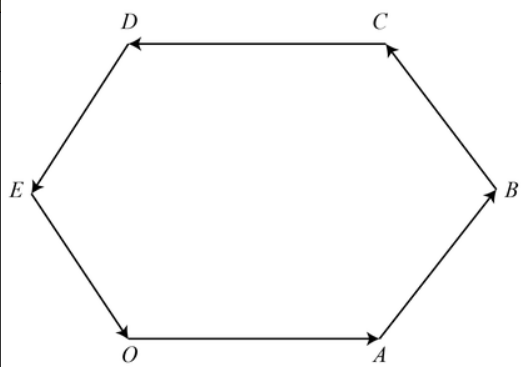
A man starts from O moves 500 m turns by ${{60}^{\circ }}$and moves 500 m again turns by ${{60}^{\circ }}$ and moves 500 m and so on. Find the displacement after (i) ${{5}^{th}}$ turn, (ii) ${{3}^{rd}}$ turn?
Answer
565.8k+ views
Hint: The entire path travelled by the man makes a hexagon. The displacement at the 5th and the 3rd turn can be calculated by the magnitude of resultant vector magnitude calculation. And as we know the resultant is the vector sum of two or more vectors. It is the result of adding two or more vectors together.
Complete step by step answer:

(i) ${{5}^{th}}$ turn
The displacement will be equal to the vector: $\overset{\to }{\mathop{OE}}\,$ as shown in the figure.
Clearly, we can say that the displacement of ${{5}^{th}}$ turn is 500 m because the man moves at turns of 500 m.
(ii) ${{3}^{rd}}$ turn
The displacement will be equal to the vector: $\overset{\to }{\mathop{OC}}\,$ as shown in the figure.
We can say that:
$\overset{\to }{\mathop{OC}}\,=\overset{\to }{\mathop{OA}}\,+\overset{\to }{\mathop{AC}}\,$
So, $\left| \overset{\to }{\mathop{OC}}\, \right|=\sqrt{{{\left| \overset{\to }{\mathop{OA}}\, \right|}^{2}}+{{\left| \overset{\to }{\mathop{AC}}\, \right|}^{2}}+2\left| \overset{\to }{\mathop{OA}}\, \right|\left| \overset{\to }{\mathop{AC}}\, \right|\cos {{90}^{\circ }}}$
Also, $\overset{\to }{\mathop{AC}}\,=\overset{\to }{\mathop{AB}}\,+\overset{\to }{\mathop{BC}}\,$
So, $\left| \overset{\to }{\mathop{AC}}\, \right|=\sqrt{{{\left| \overset{\to }{\mathop{AB}}\, \right|}^{2}}+{{\left| \overset{\to }{\mathop{BC}}\, \right|}^{2}}+2\left| \overset{\to }{\mathop{AB}}\, \right|\left| \overset{\to }{\mathop{BC}}\, \right|\cos {{60}^{\circ }}}$
Since each turn is of 500m, so $\left| \overset{\to }{\mathop{AB}}\, \right|=\left| \overset{\to }{\mathop{BC}}\, \right|=\left| \overset{\to }{\mathop{OA}}\, \right|=500$
So,
$\begin{align}
& \left| \overset{\to }{\mathop{AC}}\, \right|=\sqrt{{{\left( 500 \right)}^{2}}+{{\left( 500 \right)}^{2}}+2\left( 500 \right)\left( 500 \right)\dfrac{1}{2}} \\
& =500\sqrt{3}m
\end{align}$
Now,
$\begin{align}
& \left| \overset{\to }{\mathop{OC}}\, \right|=\sqrt{{{\left( 500 \right)}^{2}}+{{\left( 500\sqrt{3} \right)}^{2}}+2\left( 500 \right)\left( 500\sqrt{3} \right)\left( 0 \right)} \\
& =1000m
\end{align}$
Note:
In order to solve this question, remember to calculate the magnitude of a resultant vector. The displacement at the given turns are the resultant of vectors drawn from the tail and head of both vectors.
Complete step by step answer:

(i) ${{5}^{th}}$ turn
The displacement will be equal to the vector: $\overset{\to }{\mathop{OE}}\,$ as shown in the figure.
Clearly, we can say that the displacement of ${{5}^{th}}$ turn is 500 m because the man moves at turns of 500 m.
(ii) ${{3}^{rd}}$ turn
The displacement will be equal to the vector: $\overset{\to }{\mathop{OC}}\,$ as shown in the figure.
We can say that:
$\overset{\to }{\mathop{OC}}\,=\overset{\to }{\mathop{OA}}\,+\overset{\to }{\mathop{AC}}\,$
So, $\left| \overset{\to }{\mathop{OC}}\, \right|=\sqrt{{{\left| \overset{\to }{\mathop{OA}}\, \right|}^{2}}+{{\left| \overset{\to }{\mathop{AC}}\, \right|}^{2}}+2\left| \overset{\to }{\mathop{OA}}\, \right|\left| \overset{\to }{\mathop{AC}}\, \right|\cos {{90}^{\circ }}}$
Also, $\overset{\to }{\mathop{AC}}\,=\overset{\to }{\mathop{AB}}\,+\overset{\to }{\mathop{BC}}\,$
So, $\left| \overset{\to }{\mathop{AC}}\, \right|=\sqrt{{{\left| \overset{\to }{\mathop{AB}}\, \right|}^{2}}+{{\left| \overset{\to }{\mathop{BC}}\, \right|}^{2}}+2\left| \overset{\to }{\mathop{AB}}\, \right|\left| \overset{\to }{\mathop{BC}}\, \right|\cos {{60}^{\circ }}}$
Since each turn is of 500m, so $\left| \overset{\to }{\mathop{AB}}\, \right|=\left| \overset{\to }{\mathop{BC}}\, \right|=\left| \overset{\to }{\mathop{OA}}\, \right|=500$
So,
$\begin{align}
& \left| \overset{\to }{\mathop{AC}}\, \right|=\sqrt{{{\left( 500 \right)}^{2}}+{{\left( 500 \right)}^{2}}+2\left( 500 \right)\left( 500 \right)\dfrac{1}{2}} \\
& =500\sqrt{3}m
\end{align}$
Now,
$\begin{align}
& \left| \overset{\to }{\mathop{OC}}\, \right|=\sqrt{{{\left( 500 \right)}^{2}}+{{\left( 500\sqrt{3} \right)}^{2}}+2\left( 500 \right)\left( 500\sqrt{3} \right)\left( 0 \right)} \\
& =1000m
\end{align}$
Note:
In order to solve this question, remember to calculate the magnitude of a resultant vector. The displacement at the given turns are the resultant of vectors drawn from the tail and head of both vectors.
Recently Updated Pages
Why are manures considered better than fertilizers class 11 biology CBSE

Find the coordinates of the midpoint of the line segment class 11 maths CBSE

Distinguish between static friction limiting friction class 11 physics CBSE

The Chairman of the constituent Assembly was A Jawaharlal class 11 social science CBSE

The first National Commission on Labour NCL submitted class 11 social science CBSE

Number of all subshell of n + l 7 is A 4 B 5 C 6 D class 11 chemistry CBSE

Trending doubts
10 examples of friction in our daily life

One Metric ton is equal to kg A 10000 B 1000 C 100 class 11 physics CBSE

Difference Between Prokaryotic Cells and Eukaryotic Cells

1 Quintal is equal to a 110 kg b 10 kg c 100kg d 1000 class 11 physics CBSE

State the laws of reflection of light

Explain zero factorial class 11 maths CBSE




